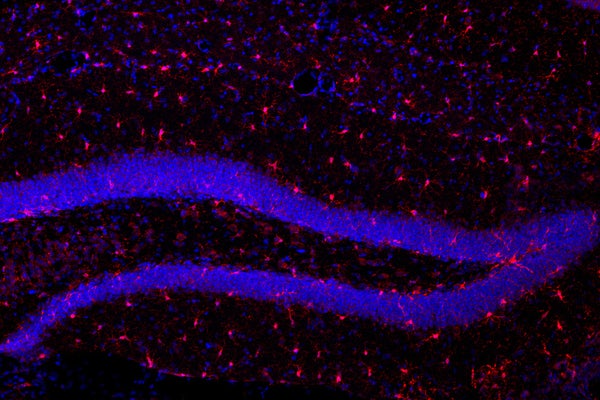Our memories are imperfect. You can probably recall who you spoke to over dinner last weekend but have likely forgotten the details of the conversation. Remembering too much can have its downsides—in conditions such as post-traumatic stress disorder, a distressing event can remain imprinted in an individual’s mind, causing continued anguish. On the other hand, excessive memory loss is also a problem. Alzheimer’s disease, for example, is marked by an inability to recollect. Using mice, scientists have now demonstrated that the brain’s resident immune cells, microglia, play a critical role in helping the organ to forget.
Microglia were once seen solely as the brain’s watchdogs—activated exclusively to guzzle pathogens and dead and dying neurons. That view has changed in recent years, as scientists have amassed evidence that these cells have wide-ranging duties: During development, they seem to help sculpt the brain by trimming away excess synapses—the connections between neurons. And microglia appear to be major players in several neurodevelopmental and neurodegenerative diseases, including autism and Alzheimer’s. Yan Gu, a neuroscientist at the Zhejiang University School of Medicine in China, says he and his colleagues were intrigued by the potential link between the work on microglial pruning during early development and prior research indicating that synapses are important for the storage and coding of memories. “We wondered whether microglia can eliminate synapses in the adult brain,” he says. “And what is the relationship between loss of synapses by microglia and forgetting?”
To address this question, Gu’s group teamed up with other researchers at Zhejiang University in a study, including neuroscientist Lang Wang. They depleted microglia from the brains of mice with drugs administered either through food or injected directly into the brain. To assess memory retention, they used contextual fear conditioning, a technique that involves placing rodents in a cage and giving them mild electric shocks. (When the animals reenter the cage, even in the absence of a shock, the memory of the experience immobilizes them.) The researchers found that although this freezing response diminished after a few weeks in healthy animals, it remained largely intact in their microglia-depleted counterparts.
On supporting science journalism
If you're enjoying this article, consider supporting our award-winning journalism by subscribing. By purchasing a subscription you are helping to ensure the future of impactful stories about the discoveries and ideas shaping our world today.
The team then conducted a series of experiments to pinpoint how, exactly, microglia mediate forgetting. They homed in on the hippocampus, a brain region involved in memory and learning, and tagged neurons that were active during the contextual fear conditioning task when the animals were making memories. (These memory-associated neurons are thought to fire together when a memory is recalled.) The researchers demonstrated that the reactivation of these cells occurred more frequently in microglia-depleted animals than in healthy ones.
Further tests revealed that forgetting was dependent on the microglia’s ability to gobble up synapses—and on the activity of neurons. Suppressing the activation of memory-associated neurons led to more forgetting in the mice, suggesting that microglia-mediated elimination was a mechanism through which less useful memories are lost. The findings were published today in Science.
“This is very exciting work,” says Paul Frankland, a neuroscientist at the Hospital for Sick Children in Toronto, who was not involved in the study but has collaborated with some of its co-authors in the past. “This is a brand-new type of forgetting mechanism that’s been discovered.” According to Frankland, there have been a number of mechanisms of memory erasure proposed over the past decade or so, including work from his group that has suggested that the formation of new neurons, neurogenesis, enables forgetting. Put simply, the idea is that adding neurons introduces new connections and breaks old ones, altering the existing pattern of synapses within engrams—ensembles of neurons where memories are stored—and making them harder to access.
Both the neurogenesis-related and microglia-mediated forgetting could be happening in concert, Frankland adds—at least in parts of the brain where neurogenesis is present. But by looking at areas in the hippocampus where neurogenesis both does and does not occur, Gu and his colleagues demonstrated that microglia-mediated forgetting could be more widespread throughout the brain. “This suggests that microglia-mediated forgetting may be a generalized form of forgetting even in brain regions without neurogenesis [such as the cortex],” Gu says.
“This was a really cool study,” says Soyon Hong, a neuroscientist at University College London, who did not take part in the work. She notes that while another group previously demonstrated that microglia are involved in synapse formation during learning, the novelty of the new paper is that it suggests these cells also play a role in synapse elimination in a healthy adult brain. There are still many mysteries that remain about the mechanism underlying this process, however. Prior research has shown that a constituent of the immune system called the complement system is involved in tagging synapses for microglia to prune. Wu and his colleagues demonstrated that this system played in role in microglia-mediated forgetting as well. But more specific questions, such as what factors control which complement proteins will tag neural connections for microglial removal remain an open question, Hong says.
Gu and his colleagues are now working on further detailing the mechanism through which microglia pinpoint synapses to target and whether such processes go awry in a neurodegenerative disease such as Alzheimer’s, in which overactive microglia may play a role. Hong, whose lab is focused on similar work, notes that the answer to these questions may have important implications in the future. “You can imagine, in the long term, for Alzheimer’s and other diseases involving memory loss, that this neuroimmune signaling pathway that’s implicated in memory could be a really specific and novel therapeutic target,” she says.
